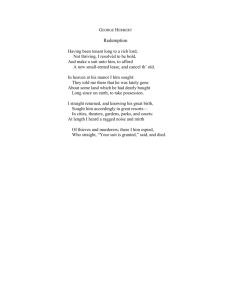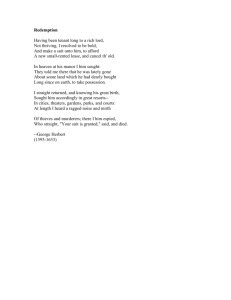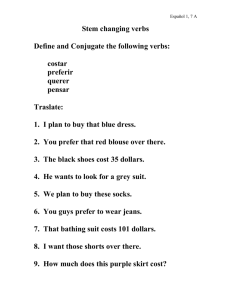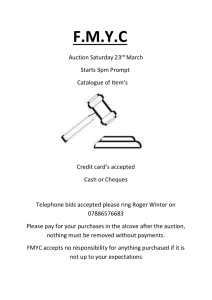INTRODUCTION
advertisement
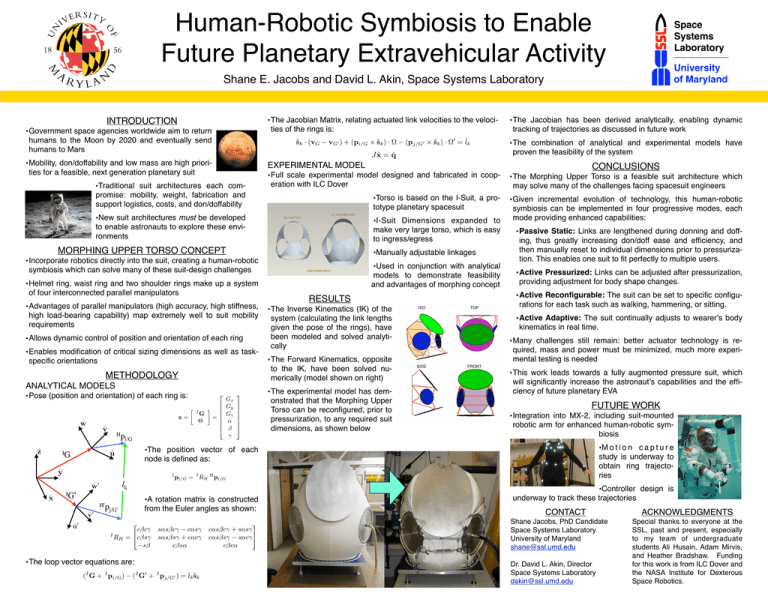
Human-Robotic Symbiosis to Enable Future Planetary Extravehicular Activity Shane E. Jacobs and David L. Akin, Space Systems Laboratory • The Jacobian Matrix, relating actuated link velocities to the velocities of the rings is: INTRODUCTION • Government space agencies worldwide aim to return humans to the Moon by 2020 and eventually send humans to Mars ŝk · (vG − vG! ) + (pi/G × ŝk ) · Ω − (pj/G! × ŝk ) · Ω! = l˙k J ẋ = q̇ • Mobility, don/doffability and low mass are high priorities for a feasible, next generation planetary suit • The Morphing Upper Torso is a feasible suit architecture which may solve many of the challenges facing spacesuit engineers •Torso is based on the I-Suit, a prototype planetary spacesuit • Given incremental evolution of technology, this human-robotic symbiosis can be implemented in four progressive modes, each mode providing enhanced capabilities: •I-Suit Dimensions expanded to make very large torso, which is easy to ingress/egress MORPHING UPPER TORSO CONCEPT •Manually adjustable linkages • Incorporate robotics directly into the suit, creating a human-robotic symbiosis which can solve many of these suit-design challenges • Helmet ring, waist ring and two shoulder rings make up a system of four interconnected parallel manipulators • Advantages of parallel manipulators (high accuracy, high stiffness, high load-bearing capability) map extremely well to suit mobility requirements • Allows dynamic control of position and orientation of each ring • Enables modification of critical sizing dimensions as well as taskspecific orientations METHODOLOGY ANALYTICAL MODELS x= G Θ I " = Gx Gy Gz α β γ CONCLUSIONS • Full scale experimental model designed and fabricated in cooperation with ILC Dover •New suit architectures must be developed to enable astronauts to explore these environments ! • The combination of analytical and experimental models have proven the feasibility of the system EXPERIMENTAL MODEL •Traditional suit architectures each compromise: mobility, weight, fabrication and support logistics, costs, and don/doffability • Pose (position and orientation) of each ring is: • The Jacobian has been derived analytically, enabling dynamic tracking of trajectories as discussed in future work •Used in conjunction with analytical models to demonstrate feasibility and advantages of morphing concept RESULTS • The Inverse Kinematics (IK) of the system (calculating the link lengths given the pose of the rings), have been modeled and solved analytically • The Forward Kinematics, opposite to the IK, have been solved numerically (model shown on right) • The experimental model has demonstrated that the Morphing Upper Torso can be reconfigured, prior to pressurization, to any required suit dimensions, as shown below • Passive Static: Links are lengthened during donning and doffing, thus greatly increasing don/doff ease and efficiency, and then manually reset to individual dimensions prior to pressurization. This enables one suit to fit perfectly to multiple users. • Active Pressurized: Links can be adjusted after pressurization, providing adjustment for body shape changes. • Active Reconfigurable: The suit can be set to specific configurations for each task such as walking, hammering, or sitting. • Active Adaptive: The suit continually adjusts to wearerʼs body kinematics in real time. • Many challenges still remain: better actuator technology is required, mass and power must be minimized, much more experimental testing is needed • This work leads towards a fully augmented pressure suit, which will significantly increase the astronautʼs capabilities and the efficiency of future planetary EVA FUTURE WORK • Integration into MX-2, including suit-mounted robotic arm for enhanced human-robotic symbiosis •M o t i o n c a p t u r e study is underway to obtain ring trajectories •The position vector of each node is defined as: I pi/G = I RH H pi/G •A rotation matrix is constructed from the Euler angles as shown: I RH cβcγ = cβsγ −sβ sαsβcγ − cαsγ sαsβsγ + cαcγ cβsα • The loop vector equations are: (I G + I pi/G ) − (I G! + I pj/G! ) = lk ŝk cαsβcγ + sαsγ cαsβsγ − sαcγ cβcα •Controller design is underway to track these trajectories CONTACT Shane Jacobs, PhD Candidate Space Systems Laboratory University of Maryland shane@ssl.umd.edu Dr. David L. Akin, Director Space Systems Laboratory dakin@ssl.umd.edu ACKNOWLEDGMENTS Special thanks to everyone at the SSL, past and present, especially to my team of undergraduate students Ali Husain, Adam Mirvis, and Heather Bradshaw. Funding for this work is from ILC Dover and the NASA Institute for Dexterous Space Robotics.
